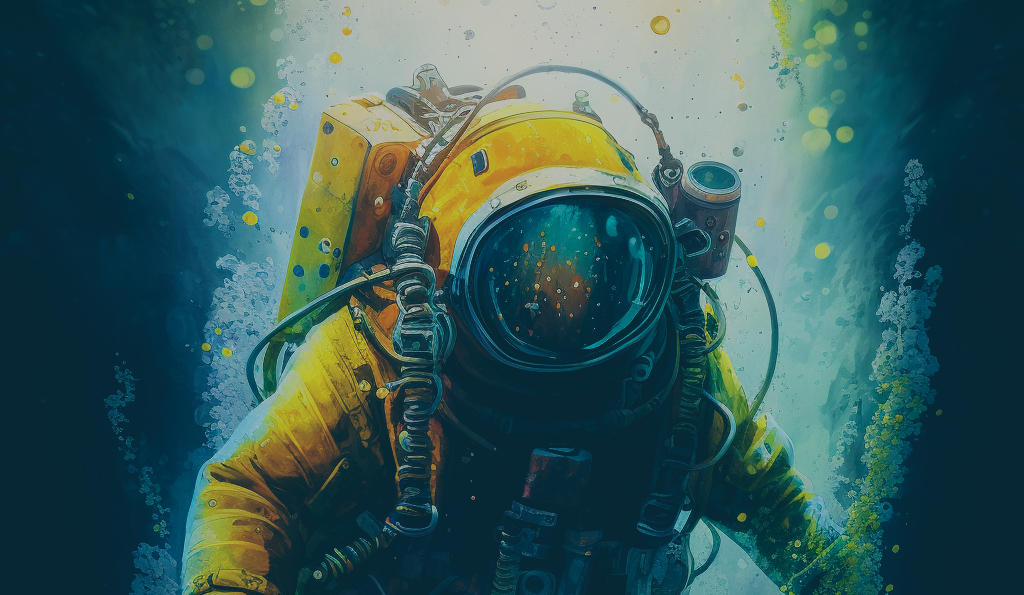AI becomes an integral part of our design work
Author
Mark Westbeek
Published
23 August 2023
Reading time
5 minutes
After a deepdive in the 'AI sandbox', we are convinced: Generative AI tools will become an integral part of our design work. AI provides valuable intermediate results, can make surprising new connections that we would not have immediately come up with ourselves. It helps to speed up our work and to ease the repetitive tasks and production work.
Deepdive in AI
In April of this year, a number of our designers immersed themselves in the world of AI for a week. A 'deep dive' to find an answer to the question of whether, and how, AI tools can help us speed up or improve our work. How does AI relate to the work of a human UX, content, service or visual designer? Wdo we all promptly order designers?
We didn't want to test specific tools, but the general concept of Generative AI. We used ChatGPT, Dall-E, and Midjourney for our research. As a guideline, we used the different phases in the design process: 'understand', 'ideate' and 'create'.
A good assistant during the understand phase
Creating a design often starts with research. Could AI do this all the way for us? For example, setting up and executing a research plan, with the question: How can a bank improve the digital experience of its customers so that they are more self-supporting?
Executing a research plan turned out to be a bridge too far during the deep dive. ChatGPT said that it "does not have access to relevant data." With the latest update of ChatGPT this is now possible. However, we were able to get recommendations for the various steps in the research process. Recommendations that are not very surprising and fairly obvious.
However, with the help of AI, we were able to quickly arrive at a representative set of personas. ChatGPT is surprisingly good at making connections between different topics within the organization that are relevant to its users. With Midjourney we were able to visualize a persona remarkably well, ChatGPT generated a detailede prompt for this . The recommendations came quickly, but were too generic and did not offer results that we would not have come up with ourselves.
For the ideate phase, AI can inspire
Can AI help us generate ideas in the ideate phase? We got to work entering prompts into ChatGPT for designing a car insurance policy. Generating innovative concepts for this insurance worked well, results were fun and sometimes really striking. Coming up with a catchy name ended in a slight disappointment. Names like 'InsureNU', 'CoverageDirect' or 'PolisPartner' are rather superficial and generic.
Devising various user flows for this car insurance resulted in few useful results, with illogical steps in the process. This is a pain point: AI answers the prompt, but doesn't ask for more context. A human designer keeps asking questions until she/he really understands what it is about, in order to come up with specific and innovative solutions.
Also when generating wireframes (via DALL· E and Midjourney) the yield was disappointing. Sure, we got pictures of wireframes. Useful especially for people who do not know what a wireframe is, but did not contain any useful material. Inspiring for visual design concepts went a lot better via Midjourney, which included remarkable results that can be used as inspiration.
Our conclusion: AI is useful for gaining inspiration in the 'ideate' phase, but the results were not specific enough to apply in practice.
Lightning fast in repetitive tasks
Our content designers have used AI in different ways in the 'create' phase. With mixed results. ChatGPT can easily convert a text from a passive writing style to an active writing style. Also, converting texts, written in the 3rd person singular (you-form), to the 1st person (I-form), yieldedquick results, which turned out to be quite good when checked.
Things did not go so well when applying a tone of voice. The words with which you describe the tone of voice in the prompt were conscientiously repeated by AI in the produced text. But not really subtle or clever. It was more like a shot of hail being fired at an existing text.
Writing for a certain language level (for example, the much sought-after language level B1) also did not go very well. ChatGPT can simplify texts and thus serve as inspiration, but when checked, the output certainly did not always meet the requirements of a certain language level. This may be partly because AI is not aware of the requirements of the European Framework of Reference. English texts and the frames of reference used in the US were already doing better.
Good as a co-pilot in development work
Our developers also unleashed AI on work in the 'Create' phase. Converting code to another framework went pretty well, as did generating codebased on specific cues. Writing documentation for components (a job that developers traditionally hiccup) also went very well.
Are developers still needed if these tasks can just as easily be performed by AI? We say a resounding yes to this. As a developer, you need to know the mental model of the framework well in order to control and apply the output. AI is strong in assisting the developer, especially with complex pieces.
AI-assisted designers
After a week of deep dive we resurfaced. With mixed positive results and feelings about the impact of AI on the design process. Our conclusion: We see a future in which the user experience of products and services is designed by AI-assisted designers. That depends on a few things:
- Good prompts: don't suffice with a first try; Ask questions, give more context, be more specific and just demand quality ;-) The better we are able to formulate prompts, and to continue to refine them, the better the answer becomes. In addition, it is interesting to see if you can 'stack' input and output. Either within one tool (within ChatGPT), or from one generative tool to another (output from ChatGPT as a prompt to Midjourney).
- Design experience: for the time being, you have to take into account that sometimes things can also go wrong, that ChatGPT, for example, hallucinates; or that he suffers from unwanted biases; You have to keep an eye on that, and correct it.
- Belief: that as a designer you can use generative AI as your buddy in the design process. And thus design an even better digital experience. You have to be and remain curious about new applications, new smarts in the field of AI; you have to stay alert to good sides and also the lesser sides. But then, yes, imagine what surprising, beautiful and meaningful digital products and services we can design. Aaaiii...
About the author

AI
Content
UX
Frontend tech



